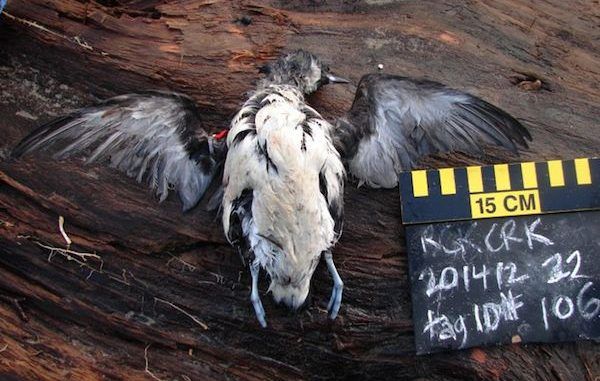
Since last October huge numbers of seabirds have been found dead along the coastline of western United States. Researchers are worrying if the die-off may spread to other birds and fish.
“This is just massive, massive, unprecedented,” said Julia Parrish, a University of Washington seabird ecologist, “We may be talking about 50,000 to 100,000 deaths. So far.”
Nationalgeographic.com reports:

BYPASS THE CENSORS
Sign up to get unfiltered news delivered straight to your inbox.
You can unsubscribe any time. By subscribing you agree to our Terms of Use
The gruesome auklet deaths come just as scientists around the globe are seeing a significant uptick in mass-mortality events in the marine world, from sea urchins to fish and birds. Although there doesn’t appear to be a link to the virus that killed tens of millions of sea stars along the same shores from California to Alaska over the past 18 months, some scientists suspect a factor in both cases may be uncharacteristically warm waters.
The U.S. Geological Survey and others have performed animal autopsies, called necropsies, on several of the emaciated Cassin’s auklets. They’ve found no evidence of disease or trauma—no viruses or bacteria, no feathers coated with spilled oil. The birds appear simply to have starved to death.
“There’s very little evidence of food in their GI [gastrointestinal] tracts or stomachs,” said Anne Ballmann, with USGS’s National Wildlife Health Center.
At first scientists weren’t too surprised by the carcasses washing ashore. When young auklets fledge in late summer, they all enter the water at the same time and start competing for food—shrimp-like krill and tiny crustaceans called copepods. For various reasons, last summer’s birth class of Cassin’s auklets was gigantic. Researchers expected a higher death toll, too.
But they now are perplexed by the sheer numbers of dead birds and the spreading geographic extent of the die-off.
“Death at this level and over this much real estate has to be from more than just that,” Parrish said.
The Culprit: Warm Water?
Bill Sydeman, a senior scientist at California’s Farallon Institute, said he believes the most likely scenario is that the deaths are related to a massive blob of warm water that heated the North Pacific last year and contributed to California’s drought and to 2014 being the hottest year on record.
That water was hotter and stayed warm longer than at any time since record-keeping began. It stretched across the Gulf of Alaska, where a high-pressure system blocked storms, preventing the water from churning to the surface and mixing with air. More warm water eventually moved inward along the coast as far south as California, altering how favorable the environment was for the zooplankton that many fish and birds, including Cassin’s auklets, feed on.
That all happened in late summer—about the same time the young auklets began to fledge.
Sydeman predicts that this spring or summer the dying might spread to the salmon and forage fish that eat those same plankton species and then perhaps to the murres or other birds that, in turn, eat those fish.
“I think there’s a strong possibility of it escalating to affect other species in the near future,” he said.

Google Cynthia bacteria. Is a synthetic bacteria created to eat the oil from the BP oil disaster, but it mutated and now consumes all organic lifeforms it comes into contact with. I am not making this up. Look it up.